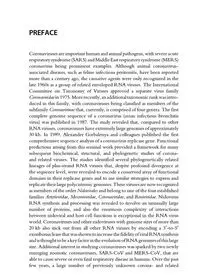
2016 [Advances in Virus Research] Coronaviruses Volume 96 __ Preface PDF
Preview 2016 [Advances in Virus Research] Coronaviruses Volume 96 __ Preface
PREFACE Coronaviruses are important human and animal pathogens, with severe acute respiratorysyndrome(SARS)andMiddleEastrespiratorysyndrome(MERS) coronavirus being prominent examples. Although animal coronavirus- associated diseases, such as feline infectious peritonitis, have been reported more than a century ago, the causative agents were only recognized in the late 1960s as a group of related enveloped RNA viruses. The International Committee on Taxonomy of Viruses approved a separate virus family Coronaviridaein1975.Morerecently,anadditionaltaxonomicrankwasintro- duced in this family, with coronaviruses being classified as members of the subfamily Coronavirinae that, currently, is comprised of four genera. The first complete genome sequence of a coronavirus (avian infectious bronchitis virus) was published in 1987. The study revealed that, compared to other RNA viruses, coronaviruses have extremely large genomes of approximately 30 kb. In 1989, Alexander Gorbalenya and colleagues published the first comprehensive sequence analysis of a coronavirus replicase gene. Functional predictions arising from this seminal work provided a framework for many subsequent biochemical, structural, and phylogenetic studies of corona- and related viruses. The studies identified several phylogenetically related lineages of plus-strand RNA viruses that, despite profound divergence at the sequence level, were revealed to encode a conserved array of functional domains in their replicase genes and to use similar strategies to express and replicate their large polycistronic genomes.These virusesare now recognized as members of the order Nidovirales and belong to one of the four established families Arteriviridae, Mesoniviridae, Coronaviridae, and Roniviridae. Nidovirus RNA synthesis and processing was revealed to involve an unusually large number of proteins, and also the enormous complexity of interactions between nidoviral and host cell functions is exceptional in the RNA virus world. Coronaviruses and other nidoviruses with genome sizes of more than 20 kb also stick out from all other RNA viruses by encoding a 30-to-50 exoribonucleasethatwasshowntoincreasethefidelityofviralRNAsynthesis andisthoughttobeakeyfactorintheevolutionofRNAgenomesofthislarge size. Additional interest in studying coronaviruses was sparked by two newly emerging zoonotic coronaviruses, SARS-CoV and MERS-CoV, that are able to cause severe or even fatal respiratory disease in humans. Over the past few years, a large number of previously unknown corona- and related xiii nidoviruses were discovered in mammals, birds, insects, fish, and reptiles, while other studies provided a wealth of new information on the biology and pathogenesis of human and animal coronaviruses. In several cases, the studies also revealed unique properties not reported previously for other RNA viruses outside the Nidovirales. The chapters included in this volume review our current understanding of important aspects of coronavirus biology and pathogenesis, including virus–host interactions, and they give an overview of new strategies in the development of vaccines and antivirals suitable to combat coronavirus infections. I hope that this book will be useful to academic researchers and their students as well as clinicians with an interest in coronavirus-related diseases and the biology of these viruses. I thank all colleagues who contrib- uted to this book and would like to express my gratitude to Prof. Thomas Mettenleiter for his encouragement and Ms. Helene Kabes and her staff for guidance and help in the preparation of this volume. JOHN ZIEBUHR Giessen, Germany August 2016 xiv Preface
